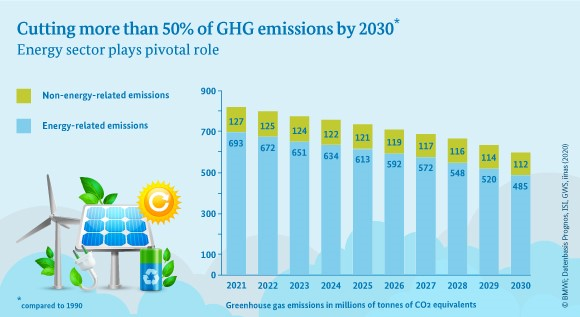Germany is a world leader in cutting emissions
Germany wants to more than halve its greenhouse gas emissions by 2030 compared to 1990. This ambitious goal was reaffirmed in the National Energy and Climate Plan (NECP) adopted in mid-June.
 © BMWi; Datenbasis Prognos, ISI, GWS, iinas (2020)
© BMWi; Datenbasis Prognos, ISI, GWS, iinas (2020)
Germany is to become more climate-friendly and cut back heavily on harmful greenhouse gas emissions within only ten years. According to estimates by research institute Prognos AG, in 2030 GHG emissions could be up to 52% lower than in 1990. On behalf of the Federal Ministry for Economic Affairs and Energy, the institute has analysed the impact of the 2030 Climate Action Programme and provided estimates that also form the basis for the emission reduction targets set out in the National Energy and Climate Plan (NECP) (in German only). According to the findings, without its Climate Action Programme, Germany would only be able to reduce its GHG emissions by 41% by 2030. The measures adopted to date, however, will enable Germany to come very close to meeting its climate target of reducing GHG emissions by at least 55% by 2030. Moreover, they could be given fresh impetus from the National Hydrogen Strategy (in German only), which was also adopted in early June, and the 130 billion euro economic stimulus package of 3 June 2020 (in German only). The package contains targeted measures that are to provide a major boost to the economy, ensure social justice and help Germany make progress on protecting the environment and climate.
With emissions estimated to fall by 52% by 2030 against 1990 levels, Germany ranks well among the highly industrialised countries. A decisive role is played by the energy sector, which Prognos predicts will cut emissions to 183 million tonnes by 2030 – a decrease of 61% compared to 1990. This means that 97% of the emissions reduction target that was set for this period will be achieved.
For 2021, Prognos estimates that energy-related greenhouse gas emissions will amount to 693 million tonnes of CO2 equivalents. This figure could fall to 613 million by 2025, and to 485 million by 2030, which would represent an overall decline of around 30%. According to the report, non-energy-related emissions could drop by about 12%, from 127 million tonnes in 2021 to just 112 million tonnes in 2030. In total, the forecast reduction of greenhouse gas emissions between 2021 and 2030 will amount to more than 220 million tonnes of CO2 equivalents (27%). The CO2 equivalent (CO2eq) is a measure used to compare the emissions of the seven different greenhouse gases based upon their global warming potential (there are six such gases in addition to CO2; more information from the German Environment Agency is available here).
It is very difficult to make accurate predictions about future trends in emissions and the effects of measures to mitigate climate change. Prognos’s scenario analysis (in German only) is based on plausible assumptions and takes into account previous developments. It is thought to provide the most realistic model of the shape of things to come.
Further information
- Study by Prognos: Projections and Impact Assessments for the Energy Sector 2030/2050 (in German only)
- Integrated National Energy and Climate Plan (NECP) (in German only)
- 2030 Climate Action Programme (in German only)
- Brochure by the Federal Ministry for Economic Affairs and Energy: The National Hydrogen Strategy (in German only)
- Article by the Federal Ministry for Economic Affairs and Energy: Coalition Committee adopts Marshall Plan 2.0 (economic stimulus package of 3 June 2020, in German only)

